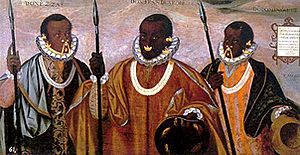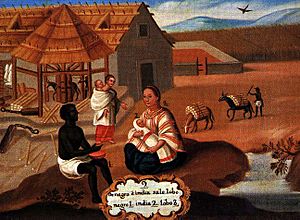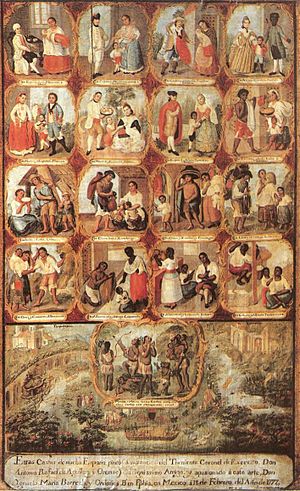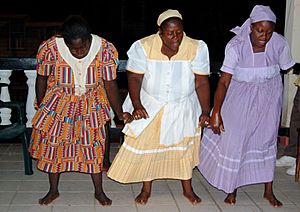Zambo facts for kids

16th-century painting of Zambo caciques from Esmeraldas, Ecuador
|
|
| Total population | |
|---|---|
| 5,804,800 in South America, unknown number overall | |
| Regions with significant populations | |
| Latin America and the Caribbean | |
| Languages | |
| Spanish, Portuguese and English | |
| Religion | |
| Christianity (predominantly Roman Catholic, minority practices Protestantism), African religions, tribal religions | |
| Related ethnic groups | |
| Garifuna, Africans, Afro-Caribbeans and Amerindians |
The word Zambo (pronounced THAM-boh or SAM-boh) is a historical term. It was first used in the Spanish Empire to describe people who had both Native American and African ancestors. Today, in some parts of the Americas, the term is still used for people with this mixed heritage.
Long ago, when enslaved Africans and Native Americans had children together, these children were sometimes called zambayga, then zambo, and later sambo. In Brazil, a similar term is cafuzo. However, in Portugal and parts of Africa where Portuguese is spoken, cafuzo means someone born from an African person and a person who is part African and part European.
Contents
What Does "Zambo" Mean?
The exact meaning of the term sambo can be different in North America. Some people think the word comes from Romance languages or Latin. The female version of the word is zamba. This is not to be confused with the Argentine Zamba folk dance.
In some parts of colonial Spanish America, zambo referred to children with one African and one Native American parent. It also described children born to two zambo parents. In New Spain (which is now Mexico), people with mixed African and Native American heritage were sometimes called lobo, meaning "wolf". This term was used in official records like marriage papers.
During that time, many other words were used to describe people with different amounts of African and Native American ancestry. For example, cambujo was used for someone who was a mix of zambo and Native American. Today, in some parts of Spanish America, zambo is a general term for anyone with a noticeable amount of both African and Native American heritage.
A Look at History
The term zambo was not always formally used in Spanish lands. Other words, like mulato, were also common. From the early 1500s, when African slaves first arrived in Hispaniola, people from different groups started to have families together. This included Africans, Native Americans, and Spanish colonists. Sometimes, Africans and Native Americans worked together in mines or on plantations, especially after sugar cane farming began in the 1520s. In other cases, Africans who escaped slavery found safety in Native American communities.
The term zambos usually described people who did not have European ancestors. However, many different kinds of families formed over the centuries. In the 1700s, the Spanish government started to make official racial groups. This is when zambo got its final, official meaning.
Early Mixed Communities
Some zambo groups became well-known. They were formed by Africans who ran away or rebelled and then joined or took over Native American communities. For example, in the Esmeraldas region of what is now Ecuador, a small group of former slaves who survived a shipwreck took control of some Native American communities. They even spoke for these communities to the Spanish authorities in the late 1500s and early 1600s.
The Miskito Zambos Story
The Miskito Zambos are another example. They came from a group of African slaves who rebelled on a slave ship in 1640. The ship crashed near Cape Gracias a Dios, on the border of Honduras and Nicaragua. The slaves escaped inland and joined with the Miskito people. By the early 1700s, these Afro-Miskito people became very powerful in the kingdom. They led many slave raids to capture people to sell to Europeans. Their friendship with English-speaking traders and settlers in the area helped Great Britain create the colony of British Honduras (which is now Belize).
Zambo People Today

Today, zambos make up a noticeable part of the population in countries like Colombia, Brazil, Venezuela, Guyana, Ecuador, and Panama. In Ecuador, a small but growing number of zambos are found in major coastal cities and in Imbabura province. These are often the children of Native American men and Afro-Ecuadorian women. Before people moved from farms to cities in Ecuador, Native Americans mostly lived in the Andes mountains, and Afro-Ecuadorians lived in Esmeraldas Province and the Chota Valley.
Garifuna People: A Unique Mix
In Central America, two main groups of mixed Native American and African people have developed: the Miskito and the Garifuna. The Garifuna came from Africans who were shipwrecked or escaped from nearby islands to St. Vincent between the 1600s and 1700s. In 1797, the British sent them away because they supported France during the French Revolutionary Wars. They were sent to the island of Roatan, off the coast of Honduras. From there, they traveled to the mainland and formed communities along the coast from Nicaragua to Belize.
Zambo Communities in Mexico
In Mexico, where zambos were sometimes called lobos (meaning "wolves"), they are a significant minority. In 2015, almost 900,000 people said they were both Afro-Mexican and Indigenous Mexican. Most of Mexico's Afro-descended population has blended into the larger mestizo population (people of mixed European and Native American ancestry). Larger groups of Afro-Mexicans can be found in communities along the southern coast. These include states like Michoacán, Guerrero, Oaxaca, Campeche, Quintana Roo, Yucatán, and Veracruz.
Culturally, Mexican lobos often followed Native American traditions more than African ones. This is because they often had Native American mothers and grew up in their culture. This blending of cultures also happened in Bolivia. The Afro-Bolivian community there took on many Native American cultural practices, such as their style of dress and using the Aymara language. These Afro-Bolivian communities live in the Yungas region of the Bolivian department of La Paz.
Facing Challenges: Racism
People with African and Native American ancestors have often faced unfair treatment and been pushed to the side.
In March 2008, former US Senator Barack Obama gave a speech. He talked about the difficult situations faced by people with African and Native American backgrounds. This showed his concern for the Zambo population in his country.
See also
 In Spanish: Zambo (casta) para niños
In Spanish: Zambo (casta) para niños
- Afro-Latin Americans
- Black Indians
- Black Seminoles
- Casta
- Cholo
- Garifuna people
- Lobo (racial category)
- Marabou
- Mestee
- Mestizo
- Miskito
- Miscegenation
- Mulatto
- List of topics related to the African diaspora





